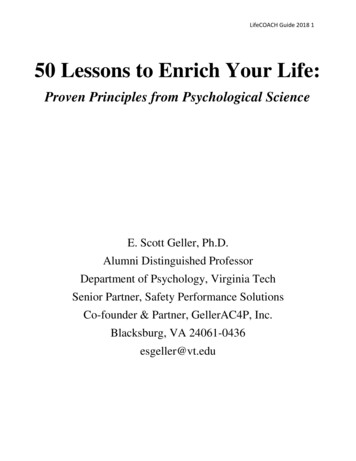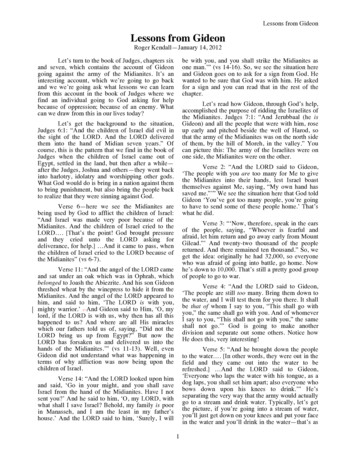
Transcription
LifeCOACH Guide 2018 150 Lessons to Enrich Your Life:Proven Principles from Psychological ScienceE. Scott Geller, Ph.D.Alumni Distinguished ProfessorDepartment of Psychology, Virginia TechSenior Partner, Safety Performance SolutionsCo-founder & Partner, GellerAC4P, Inc.Blacksburg, VA 24061-0436esgeller@vt.edu
LifeCOACH Guide 2018 250 Lessons to Enrich Your Life:Proven Principles from Psychological ScienceCopyright 2018 by E. Scott Geller, Ph.D.Text Processing: Kasey WarrenIllustrations: George V. WillsCover Design: Kasey WarrenAll rights reserved, including the right to reproduce thiswork in any form whatsoever without permission inwriting from the publisher, expect for brief passes inconnection with a review. For more information write:GellerAC4P, Inc.Make-A-Difference, LLC.161 Make-A-Diff DriveP.O. Box 73 Newport, Virginia rformance.comISBN: 978-1-890296-17-9 paperbackISBN: 978-1-890296-18-6 eBookLibrary of Congress Control Number is available upon requestPrinted in the United States of America
LifeCOACH Guide 2018 350 Lessons to Enrich Your LifeTable of ContentsIntroductionWhy a LifeCOACH Guide?How to Use this LifeCOACH GuideFamily ApplicationsList of the 50 Life LessonsLife Lesson 1: The Nature/Nurture InteractionLife Lesson 2: Behavior is Motivated by ConsequencesLife Lesson 3: Activate Behavior with ConsequencesLife Lesson 4: Manage Behavior with Extrinsic ConsequencesLife Lesson 5: Promote Natural Behavioral ConsequencesLife Lesson 6: The Power of Natural ConsequencesLife Lesson 7: The Power of Emotional IntelligenceLife Lesson 8: Use More Supportive FeedbackLife Lesson 9: The Power of Behavioral PraiseLife Lesson 10: Promote Success SeekingLife Lesson 11: Make Feedback BehavioralLife Lesson 12: Make Praise GenuineLife Lesson 13: The Power of Observational LearningLife Lesson 14: Behavioral Observations Teach Social AcceptanceLife Lesson 15: Social Norms are Injunctive and/or DescriptiveLife Lesson 16: Mandates Can Activate Contrary BehaviorLife Lesson 17: The Power of Perceived ChoiceLife Lesson 18: The Power of Building CompetenceLife Lesson 19: The Power of InterdependenceLife Lesson 20: The Power of a Win/Win MindsetLife Lesson 21: Interdependence Enables Synergy
LifeCOACH Guide 2018 4Life Lesson 22: Watch Out for GroupthinkLife Lesson 23: Diversity Optimizes SynergyLife Lesson 24: The Power of Systems ThinkingLife Lesson 25: The Power of Feeling EmpoweredLife Lesson 26: Communicate with EmpathyLife Lesson 27: Live by the Platinum RuleLife Lesson 28: The Power of ReciprocityLife Lesson 29: The Door-in-Face TechniqueLife Lesson 30: The Foot-in-the-Door TechniqueLife Lesson 31: Consistency Fuels CommitmentLife Lesson 32: The Power of AuthorityLife Lesson 33: The Attraction of SimilaritiesLife Lesson 34: All Perception is SelectiveLife Lesson 35: Biases of AttributionLife Lesson 36: The Fundamental Attribution ErrorLife Lesson 37: The Self-Serving BiasLife Lesson 38: Self-Talk Can Help or HurtLife Lesson 39: Stress is Good; Distress is BadLife Lesson 40: We Can’t Control EverythingLife Lesson 41: Optimists Experience Less DistressLife Lesson 42: The Good and Bad of Type ALife Lesson 43: Discrimination is Good; Stereotyping is BadLife Lesson 44: The Power of ConversationLife Lesson 45: The Power of EmpathyLife Lesson 46: Build Interpersonal TrustLife Lesson 47: Behavior Precedes EmotionLife Lesson 48: Perception Determines JusticeLife Lesson 49: We Learn Every Day in Three WaysLife Lesson 50: The Legacy of Teaching and Learning
LifeCOACH Guide 2018 5Fifty Lessons to Enrich Your LifeIntroductionThis is not a typical textbook or self-help manual. Rather, it is a primerfor developing self-awareness and insight through engaging ininterpersonal conversation. Instructive and entertaining illustrations areprovided for each of the 50 lessons relevant to enriching your life, alongwith related discussion questions to initiate interpersonal andintrapersonal (i.e., self-talk) conversation about each life lesson.Information is provided regarding the research-based foundationand importance of each life lesson. This could be used to inform adiscussion leader before facilitating a group conversation, or to enlightenall participants after the consideration of a particular life lesson.I designed this LifeCOACH guide to inspire qualityteaching/learning conversations among diverse groups of individuals ofall ages—anyone interested in applying psychological science to enrichpersonal and interpersonal well-being. For more than 50 years I havestudied, taught, and researched the science of human experience. Thisjourney has made me realize the utmost value of applying these 50evidence-based life lessons to enrich the quality of our lives.I hope you will use this LifeCOACH guide to understand,appreciate, and enrich the human dynamics of everyday life. The focusis on situations involving human behavior. These range from educationalsettings and the workplace to the home—all aspects of life we encounterdaily. This LifeCOACH guide can be used to engage students,employees, and family members in teaching/learning conversationsabout the psychology of health, safety, relationship-building, and lifesatisfaction. For example, ask a discussion group this question: Whichlife lessons could we apply to cultivate a brother’s/sister’s keeper cultureof safe and satisfied students, employees, friends, or family members?
LifeCOACH Guide 2018 6I hope readers will share these 50 life lessons and their variousapplications with family, friends, students, and acquaintances. Whenunderstood and applied routinely and extensively, the life lessonselucidated in this LifeCOACH guide will most certainly enhance humanwelfare and well-being. Interpersonal conflict and bullying will bereduced. Work productivity, environmental conservation, and lifesatisfaction will be enhanced. People will feel more empathy and showmore compassion toward others, and they will perform more intentionalacts of kindness. We refer to such behavior as actively caring for l life lessons reflect the behavioral-science principles ofpositive versus negative reinforcement, observational learning, andbehavior-based feedback. Other life lessons reflect humanism, includingempathy, interdependence, systems thinking, and self-transcendence.A number of other life lessons are derived from social psychology,including six principles of social influence, the dynamics of groupdecision-making, and critical distinctions between discrimination andstereotyping. Domains of psychology such as sensation and perception,personality, health and stress, learning, and motivation are thefoundation of other life lessons.This LifeCOACH guide was initially designed to inspire qualityteaching/learning conversations between parents and their children, fromchildhood to adolescence. But after showing drafts of this guide to mystudents, many suggested applications of this teaching/learning toolbeyond the family. Several of my students suggested it should be used toinspire and inform discussions among college students.I am encouraged by the potential large-scale applications of thisLifeCOACH guide as a tool to activate constructive teaching/learningconversations among diverse groups of individuals of all ages—anyoneinterested in learning how human dynamics can enhance personal andinterpersonal well-being.
LifeCOACH Guide 2018 7Why a LifeCOACH Guide?This workbook/manual is referred to as a LifeCOACH guide. Thepsychological science revealed and explicated here connects directly toeveryday life—the science of human experience. Interpersonal coachingis one sure way to apply these life lessons for the benefit of humandynamics and well-being. But why are the letters of coach capitalized?COACH represents an interpersonal or intrapersonal sequence ofevents relevant for applying a particular life lesson (e.g., feedback,praise, observational learning, systems thinking, empathy,empowerment, and social influence techniques) to improve the behaviorof oneself and others.The coaching process begins with Caring. This is not a “gotcha”process focused on finding faults or mistakes in other people. It is anactively-caring-for-people (AC4P) process. People acknowledge andsupport the desirable behavior of others and strategically point outopportunities for continuous improvement.“When you know I care, you will care what I know. In fact, I careso much I’m willing to observe your behavior—with your permission ofcourse—and offer useful behavior-focused feedback”. This quotationreflects the critical Observation phase of AC4P coaching. Sometimes abehavioral checklist is used to look for certain desirable and undesirablebehaviors, as well as the environmental determinants of those observedbehaviors.Whether checklist-assisted or not, the objective is to Analyze theongoing interaction of specific behaviors and the environmentalconditions that facilitate or inhibit those behaviors. These observationsand interpretations are shared with the individual observed in the nextstep of AC4P coaching—Communication.Behavior can only improve with behavior-based feedback, and thisoccurs during the Communication phase of AC4P coaching.
LifeCOACH Guide 2018 8Appreciation and acceptance of supportive and corrective feedbackdepend on appropriate delivery of the behavioral feedback.Various life lessons in this LifeCOACH guide explain andillustrate how to deliver supportive and corrective feedback. This isessential, but there is more. Several life lessons shed light on the humandynamics that influence the perception and appreciation ofenvironmental determinants of behavior; how we should receivesupportive and corrective feedback; and how our subsequent, thoughtfuldecision-making can be biased, as well as improved.If the person observed perceives the Communication phase to beconstructive, the last letter of COACH reflects the outcome—Help. Aneffective behavior-based AC4P coaching process helps people improveat a targeted task, whether the focus is health, safety, security,production, instruction, research, scholarship, or athletics.Note that the AC4P coaching process benefits both the observerand the person observed. The individual observed learns certainbehaviors to continue and/or discontinue. But the act of pinpointingthose behaviors instructs and motivates related behavior of the AC4Pcoach. When AC4P coaches hold people they observe accountable to dotheir best, the coaches in turn develop self-accountability and selfpersuasion to follow their own advice (Life Lessons 17, 18, & 19).When more people coach each other effectively, the potential toachieve an organizational, educational, sports, or family AC4P missionincreases dramatically. When the mission and behavioral objectivestarget human health, safety, welfare and/or security, the process supportsthe achievement of an AC4P culture. Indeed, cultivating an AC4Pbrother’s/sister’s keeper culture depends on increasing the quantity andimproving the quality of interpersonal AC4P coaching for the safety,health, success, security, and well-being of oneself and others.
LifeCOACH Guide 2018 9How to Use this LifeCOACH GuideThis LifeCOACH guide was designed to promote conversation,learning, and beneficial applications. An optimal way to use this guide:A group leader reads the page following the illustration for a particularlife lesson and then facilitates a discussion about that life lesson.Discussion questions are presented with each illustration, but it’sexpected that additional questions will evolve from the group discussion.The size of the discussion group can vary from two to 30 or more.Constructive teaching/learning conversations about the life lessons canoccur between two individuals or among the participants in a schoolclassroom or at a corporate workshop led by a teacher or facilitator.Discussion groups or recitation sections for introductorypsychology classes in high school, community colleges, or universitiesare the most obvious applications for this LifeCOACH guide. But selectlife lessons can facilitate critical discussions and collaborative teachingand learning in corporate workshops designed to enhance jobsatisfaction, interdependent teamwork, or occupational health and safety.The life lessons and presentation format are relevant forparticipants of any educational level, from elementary school to college.The illustrations and the related discussion questions can be understoodby anyone who can read, verbalize opinions, and answer questions. Ofcourse, the teaching/learning success of a conversation about a lifelesson will depend on the skill of a teacher or group facilitator at makingthe life-lesson discussions relevant for the particular participants.As indicated above, my initial purpose for preparing thisLifeCOACH guide was to teach fundamental principles of psychology tothe general public through conversations among family members. Iimagined this LifeCOACH guide located in the family room of ahome—readily available to attract the attention of visitors and activate afriendly teaching/learning conversation.
LifeCOACH Guide 2018 10The Language of Applied Behavioral Science (ABS)Some language of psychologists is unique and quite different from thatused in everyday discourse. Plus, behavioral scientists commonly useterminology that is uncommon in other domains of psychologicalscience. Moreover, my students and I have coined certain AC4P termsand distinct ways of defining some related psychological concepts. Thus,a Glossary of Key Terms used in this LifeCOACH guide is providedafter Life Lesson 50, with definitions from an applied behavioralscience (ABS) and an AC4P framework (i.e., humanistic behaviorism).Even if you have had one or more courses in psychology, I suggestyou review the terms and definitions in the Glossary. Many terms aredefined with a behavioral and/or an AC4P focus, and often this results ina distinct difference from the more common usage of a term. Forexample, operational (i.e., behavioral or observable) definitions areoffered whenever relevant and appropriate.You might benefit from referring back to this Glossary of KeyTerms when coming across particular ABS or AC4P jargon in thedescription of a life lesson. Or when discussing answers to questionsdesigned to activate critical thinking, interpersonal conservation, and/oraction planning relevant to a particular life lesson.A Glossary term is bold and italicized in the text when it’s used forthe first time. This term might be italicized for emphasis later, as well asother words. Quotations are used to reflect words spoken by anindividual or to call attention to unique or instructive language.Family Applications: A Personal PerspectiveThroughout my childhood in the 1940s and 50s, I learned a lot about lifethough family discussions. My parents, sister and brother always haddinner together, usually at home but almost weekly at a local diner. Wewere not distracted by television in those days, so our only source ofentertainment at mealtime was family conversation.
LifeCOACH Guide 2018 11When I became a parent in the 1980s, our family—Mom, Dad,Mother-in-Law, and two daughters—had dinner together every evening.Dinner conversations rarely included everyone because our TV was inthe dining room and local news was on throughout dinnertime. Andeveryone was in a hurry to “eat and run”. Mom and Grandma cleared thetable as soon as we finished eating—in 30 minutes or less. The girls ranoff to play, watch TV, or do their homework, and I left to play tennis orattend to university responsibilities if the weather was inclement.Bottom line: My family missed out. We did not benefit optimally fromteaching/learning conversations at mealtime, as I had experienced andvalued as a child.What about today? My guess is the typical family has feweropportunities for group conversations than did families in all priorgenerations. In fact, most parents today likely have fewer one-to-oneconversations with their children than prior generations, at least after achild is old enough to use a cell phone, video game, or a computer. Thisdecrease in interfamilial teaching/learning conversations can beprofoundly damaging to a culture.Consider the power of interpersonal conversations among parentsand their children throughout generations to help develop shared beliefs,values and commitments. Note how that power has been diminished bythe variety of distractions these days—and the speed of our lives—thatlimit opportunities for one-one-one communication between childrenand their caregivers.An intervention to improve the quality of these conversationsshould be useful, given the limited parent-to-child quality time thesedays. A tool that increases the teaching/learning benefits of crucialparent-to-child communication would provide significant valuewhenever it’s used. Even better would be a tool that activates andincreases the occurrence of quality parent-child conversations. That isindeed a primary purpose of this LifeCOACH guide.
LifeCOACH Guide 2018 12This LifeCOACH Guide is dedicated to the families andfriends of the thirty-three Hokies who lost their lives onApril 16th, 2007.Ross A. AlameddineChristopher James BishopJuan Ramon Ortiz-OrtizJarrett Lee LaneMatthew Joseph La PorteMinal Hiralal PanchalHenry J. LeeBrian R. BluhmDaniel Alejandro Perez CuevaLiviu LibrescuErin Nicole PetersonRyan Christopher ClarkMichael Steven Pohle, Jr.Austin Michelle CloydJulia Kathleen PrydeJocelyne Couture-NowakMary Karen ReadKevin P. GranataReema Joseph SamahaMatthew Gregory GwaltneyCaitlin Millar HammarenWaleed Mohamed ShaalanJeremy Michael HerbstrittLeslie Geraldine ShermanRachael Elizabeth HillEmily Jane HilscherG.V. LoganathanLauren Ashley McCainMaxine Shelly TurnerPartahi M. H. LumbantoruanNicole Regina WhiteDaniel Patrick O’Neil
LifeCOACH Guide 2018 13Life Lesson 1: The Nature/Nurture InteractionDiscussion Questions:1. What does this illustration mean to you?2. How might the environment (i.e., nurture) affect the student’sreport card?3. How could heredity (i.e., nature) influence the student’s reportcard?4. Discuss some ways you have been influenced by the environment(i.e., nurture) to do good and/or bad.5. How might your behavior be influenced by heredity (i.e., nature)?For example, do you have one or more personality traits thatinfluence your actions? Please explain?
LifeCOACH Guide 2018 14Life Lesson 1: The Nature/Nurture InteractionDecades ago this first life lesson was identified as the nature/nurturecontroversy. Today, the nature/nurture issue is no longer a question or acontroversy. It’s now understood that people’s behavior results from anongoing interaction between nature and nurture.Contemporary psychology—the science of human experience—addresses the impact of both personality traits (i.e., innate dispositions)and situational events (e.g., behavioral consequences) on humanbehaviors, attitudes, and emotions. For example, a primary mission ofthe burgeoning discipline of neuroscience is to identify connectionsbetween human behavior and specific areas and neuropathways of thebrain. Identifying the behavioral functions of particular brain areas willpresumably lead to improved interventions to benefit human welfare.The significant impact of nature (e.g., biology and neurology) onbehavior cannot be denied, but this LifeCOACH guide focuses onfactors we can control for behavioral improvement. For example, twopersonality traits—conscientiousness and introversion—have significantimpact on people’s behavior. When personality dispositions are treatedlike “states” rather than “traits,” a nurture approach becomes relevant.Regarding conscientiousness, situational factors can be establishedto increase an individual’s self-motivation, persistence, and resilience, inspite of a relatively low score on a measure of conscientiousness. Forthose born with a proclivity to avoid human interaction (i.e., introverts),environmental conditions can be established to increase the occurrenceof interpersonal communication for these folks. But of course, humaninteraction is more likely among extraverts, regardless of situationalfactors. And, this personality trait will interact with external factors toaffect more interpersonal communication among extraverts thanintroverts.Consider how a personality trait is analogous to handedness.While most of us were born with a preference to use our right or lefthand (nature), we can teach ourselves to use the other hand quite wellwith practice (nurture).
LifeCOACH Guide 2018 15Life Lesson 2: Behavior is Motivated by ConsequencesDiscussion Questions:1. How does this illustration reflect this life lesson?2. How much of what you do—your behavior—is influenced by anexpectation of a positive or negative consequence?3. List some consequences (rewards or penalties) that influence yourbehavior these days.4. What consequences (positive or negative) have been unsuccessfulat influencing your behavior?5. What behavior, if any, do you perform that is not motivated by anobservable consequence?
LifeCOACH Guide 2018 16Life Lesson 2: Behavior is Motivated by ConsequencesB.F. Skinner, the founder of the research and scholarship domain ofexperimental behavior analysis, is known for the simple but profoundprinciple—selection by consequences.1 Indeed, Skinner and hisfollowers have demonstrated over and over that behavior occurs to gainpositive consequences and to avoid or escape negative consequences.Plus, behavior can be modified by changing the events that follow it.Influencing behavior by manipulating the environmental eventsthat precede and follow a target behavior is called applied behavioranalysis (ABA) by some and applied behavioral science (ABS) byothers. ABA/ABS is the most successful approach for treating childrenwith autism, and it has been applied worldwide to address the humandynamics of occupational health and safety (OH&S).The application of behavioral science to prevent personal injuriesand fatalities in the workplace is known as behavior-based safety (BBS)or behavioral safety in the corporate world.2 Peer-to-peer coaching is afundamental process of BBS. Workers develop a checklist of safe andat-risk behaviors and follow the steps of COACH as reviewed above.At this point, it’s most important to recognize that much of ourbehavior is influenced by consequences we expect to gain, avoid, orescape by performing a particular behavior. We are motivated bybehavioral consequences or the expected outcome(s) of our behavior.Realize also that the experimental and applied behavioral science (ABS)of analyzing and improving behavior is founded on this basicprinciple—behavior occurs to gain a positive consequence or to avoid orescape a negative consequence.Other relevant life lessons in this LifeCOACH guide cover thefollowing aspects of consequences which you might want to considernow: a) positive consequences are more effective than negativeconsequences at improving behavior, b) the best positive consequencesactivate and/or support self-motivation or self-directed behavior, and c)natural (or intrinsic) consequences have special advantages over extra(or extrinsic) consequences.
LifeCOACH Guide 2018 17Life Lesson 3: Activate Behavior with ConsequencesDiscussion Questions:1. What does the sign on the back of the vehicle mean to you?2. Why might this sign work better to influence driving behavior thana simpler sign like “Please Drive Safety”?3. Why is the girl (the driver) unhappy about the sign?4. What kind of driving behaviors (safe or unsafe) would be reportedmore often? Why?5. Please specify any signs or messages in your current life space thatwould be more powerful if it included a consequence.
LifeCOACH Guide 2018 18Life Lesson 3: Activate Behavior with ConsequencesApplied behavioral science is founded on a basic ABC Model. “A”represents activator or the antecedent event(s) immediately preceding“B”—the behavior. “C” stands for the consequence—event(s) followinga behavior that influence its recurrence.An activator is an incentive when it announces the availability of apositive consequence—a reward—following the occurrence of aparticular desirable behavior. In contrast, an activator is a disincentivewhen it announces the availability of a negative consequence—apenalty—following the occurrence of a designated undesirable behavior.In this illustration, the sign—an activator—could be an incentiveor a disincentive, depending on the perception of the driver. In this case,the driver sees the sign as a disincentive, expecting other drivers toreport only occurrences of undesirable or unsafe driving behaviors theyobserve.Why doesn’t the driver expect a phone call about desirable (i.e.,safe) driving behavior? Is this because the driver will not be drivingsafely and not be eligible for a positive phone call? Of course not, but itwould be instructive to discuss various answers to this question.You will likely come to the disappointing conclusion that peopleare more likely to notice and criticize undesirable behavior than noticeand recognize desirable behavior. This is a critical issue and the themeof Life Lesson 8.Consider how our culture influences a focus on undesirablebehavior, and the use of negative consequences to eliminate suchbehavior. The news media reports more about unwanted than wantedbehavior, and the government approach to behavioral control is to pass alaw and enforce it. We seem to live in a “Click it or Ticket” society.But as noted in the prior life lesson, behavioral science hasdemonstrated various advantages of using positive over negativeconsequences to increase the frequency and/or improve the quality ofbehavior.
LifeCOACH Guide 2018 19Life Lesson 4: Manage Behavior with Extrinsic ConsequencesDiscussion Questions:1. What will happen to the money under the sign if the waitressshows an improvement in her service?2. What will happen to the pile of bills under the sign if the waitressshows a decrease in her service?3. Do you think this technique would influence the behavior of theserver(s) where you dine out? Why or why not?4. How does this table-sign reflect the power of behavioralconsequences (i.e., Life Lesson 2)?5. What other signs like this could be used to influence behavior inyour life space? Please explain.
LifeCOACH Guide 2018 20Life Lesson 4: Manage Behavior with Extrinsic ConsequencesThe illustration for this life lesson depicts a fundamental intervention forchanging behavior, as illustrated and discussed for Life Lesson 3. Thetable sign provides both an incentive and a disincentive. This activatorindicates that more money (i.e., a reward) will be added followingdesirable service behavior of the waitress, but money will be taken away(i.e., a penalty) if the service of the waitress is below expectations.Incentives and disincentives are considered if-then contingencies.If you perform a certain behavior you will receive a positiveconsequence—an incentive/reward contingency—or a negativeconsequence—a disincentive/penalty contingency. Managing behaviorwith an incentive/reward contingency and/or a disincentive/penaltycontingency is termed contingency management.An if-then contingency could be stated as an opportunity toperform an enjoyable activity (e.g., watch a favorite T.V. show) afterperforming a less pleasant but desirable behavior (e.g., complete acertain work assignment). This contingency is based on the finding thatbehaviors occurring naturally at high rates can be used to increase theoccurrence of behaviors occurring at low rates.3 Students use thismanagement technique when they reward themselves with a desirablebehavior (e.g., read and send a text message) after completing a certainclass assignment.Parents who reward their children for desirable behaviors (e.g.,making their bed, reading a book, or practicing a musical instrument) orfor desirable outcomes of behavior (e.g., high grades in school, a bookreport, or a clean bedroom) are motivating desirable behavior withcontingency management.Most salary employees and wage-workers receive a regularpaycheck after a certain time (e.g., after one or two weeks). However,since this financial compensation is usually not determined by theoccurrence of designated behaviors, most employers and supervisors arenot benefiting from contingency management.
LifeCOACH Guide 2018 21Life Lesson 5: Promote Natural Behavioral ConsequencesDiscussion Questions:1. Why did Billy complete the math problem?2. What might happen if Billy does not receive an extrinsic rewardfor his problem-solving behavior?3. Is there a natural positive consequence for Billy’s correctresponse? Please explain.4. How could the teacher help Billy appreciate the intrinsic (i.e.,natural) consequence(s) of his problem-solving behavior?5. Please describe an extra consequence that motivated you toperform a particular desirable behavior. Did the extra extrinsicconsequence decrease the influence of an intrinsic or naturalbehavioral consequence? Please explain.
LifeCOACH Guide 2018 22Life Lesson 5: Promote Natural Positive ConsequencesThe illustration for this life lesson reveals a criticism that variouspop-psychology books have used to discredit the use of positiveconsequences or rewards to increase the frequency of desirable behavior.This critique is reflected by the title of one of those books: Punished byrewards: The trouble with gold stars, incentive plans, A’s, praise, andother bribes.4 Authored by a journalist and published in 1993, thispopular self-help book caused quite a stir among behavioral scientistswho have researched and demonstrated the benefits of using positiveconsequences to motivate behavior since the 1950s.Systematic reviews of research related to the pop-psychologycritique of extrinsic rewards have revealed the following: a) Asillustrated in Life Lessons 2, 3, and 4, consequences desired bypar
is one sure way to apply these life lessons for the benefit of human dynamics and well-being. But why are the letters of coach capitalized? COACH represents an interpersonal or intrapersonal sequence of events relevant for applying a particular life lesson (e.g., feedback, p










